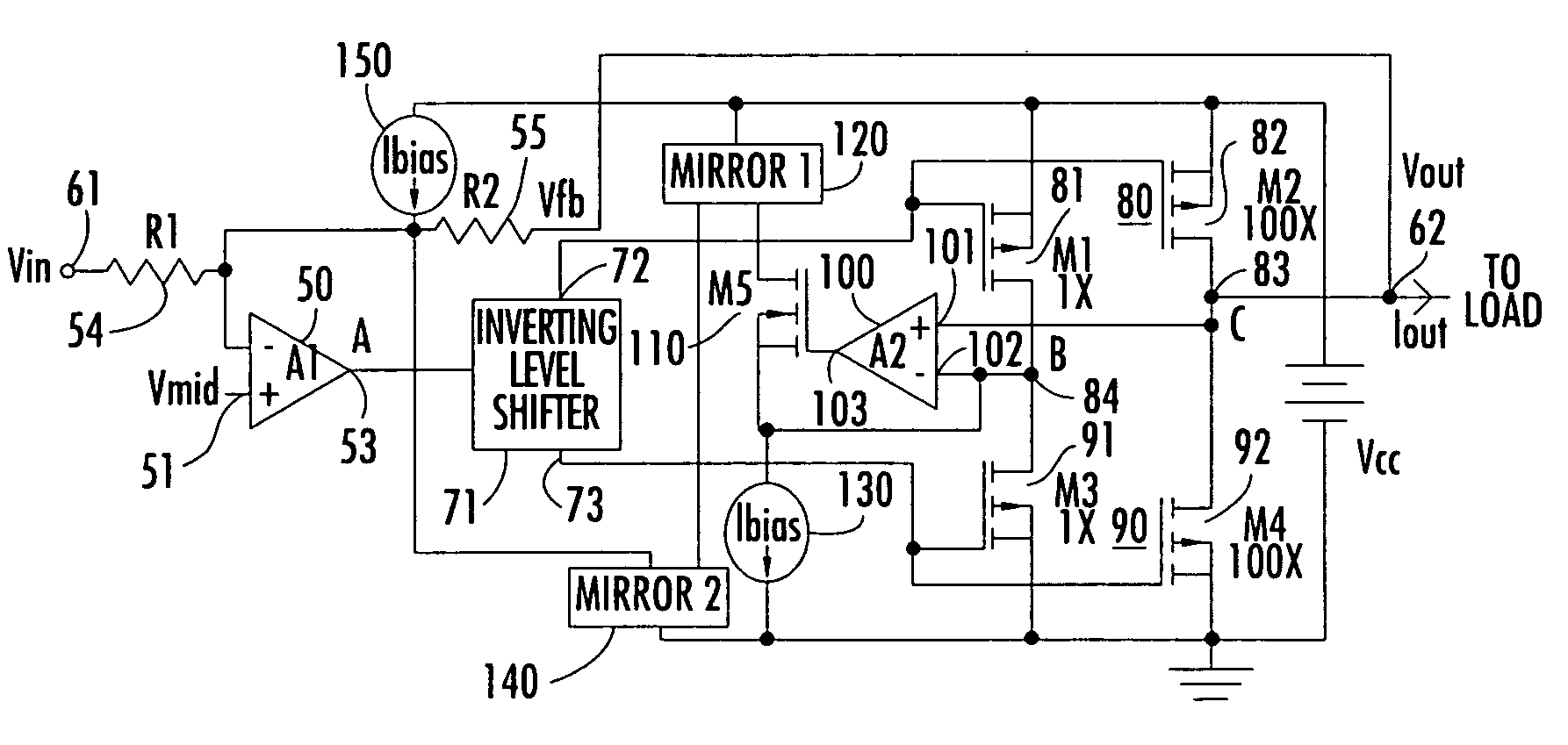Telecommunication line driver having synthesized output impedance derived from output current sensing circuit
- Summary
- Abstract
- Description
- Claims
- Application Information
AI Technical Summary
Benefits of technology
Problems solved by technology
Method used
Image
Examples
first embodiment
[0034]As referenced above, FIG. 5 shows a single ended implementation of the sensed output current-based synthesized impedance line driver of the invention. To compensate for distortion that may result from non-linearities in the ratios of the geometries of the current mirror and output MOSFETs a pair of the drivers of FIG. 5 may be coupled in a bridge configuration.
[0035]The fact that output MOSFETs 82, 92 and current mirror MOSFETs 81, 91 of FIG. 5 do not see the same drain-source voltage can be a significant source of distortion, preventing the mirror current MOSFETs 81 and 91 from tracking output MOSFETs 82 and 92, respectively. This problem is remedied by the embodiment of FIG. 6, in which the input resistor 54 of FIG. 5 is removed, and the input Vin is applied to the non-inverting (+) input 51 of operational amplifier 50. Due to the high gain of the amplifier 50, both of its inputs 51 and 52 are maintained at substantially the same voltage.
[0036]In the no-load case, the voltag...
third embodiment
[0037]As shown in FIG. 7, this effect can be compensated for a given load impedance by inserting a first auxiliary resistor 86 (having a value R4) in the mirrored current feedback path 85, and coupling the current mirror node 84 through a second auxiliary resistor 87 (having a value R3) to the reference voltage (Vmid) applied to the non-inverting input 51 of amplifier 50. Defining the mirrored current ratio Ifb / Iout as k, the output impedance Zout of the embodiment of FIG. 7 becomes
Zout={(k*R2*R3) / (R3+R4)}*{1+(k*R3) / (R3+R4)}.
[0038]If V84 is constrained to equal V83 for a given value of load resistance RL, then (k*R3*R4) / (R3+R4)=RL||R2.
[0039]By choosing k and Vout as independent variables, the values of R2, R3 and R4 are to be determined. It may be noted that R1 is only a portion of the open circuit voltage expression: Vout / Vin={−R2 / R1}*{1 / (1+(k*R3) / (R3+R4)}. As a result, there are the impedance constraining equation (Zout=RL), the voltage matching equation, and three unknowns. Altho...
fourth embodiment
[0045]FIG. 8 shows the invention, which is configured to ensure that the voltage at the current mirror node 84 always tracks the output voltage at the output current node 83, and thereby removes current mirror distortion for all values of load resistance. For this purpose, a second, ‘feedback’ operational amplifier 100 has a first, non-inverting (+) input 101 coupled to node 83 and a second inverting (1) input 102 coupled to the current mirror node 84. The output 103 of the feedback operational amplifier 100 is coupled as the gate drive for a MOSFET 110, which has its source-drain path coupled to voltage rails Vcc and GND through a first auxiliary current mirror circuit 120 and a first auxiliary bias current (Ibias) source 130, referenced to GND, respectively. The first auxiliary bias current (Ibias) source 130 serves to maintain MOSFET 110 conducting for both polarities of output current (and also current through MOSFETs 81, 91).
[0046]A second auxiliary current mirror circuit 140 i...
PUM
 Login to View More
Login to View More Abstract
Description
Claims
Application Information
 Login to View More
Login to View More - R&D
- Intellectual Property
- Life Sciences
- Materials
- Tech Scout
- Unparalleled Data Quality
- Higher Quality Content
- 60% Fewer Hallucinations
Browse by: Latest US Patents, China's latest patents, Technical Efficacy Thesaurus, Application Domain, Technology Topic, Popular Technical Reports.
© 2025 PatSnap. All rights reserved.Legal|Privacy policy|Modern Slavery Act Transparency Statement|Sitemap|About US| Contact US: help@patsnap.com



